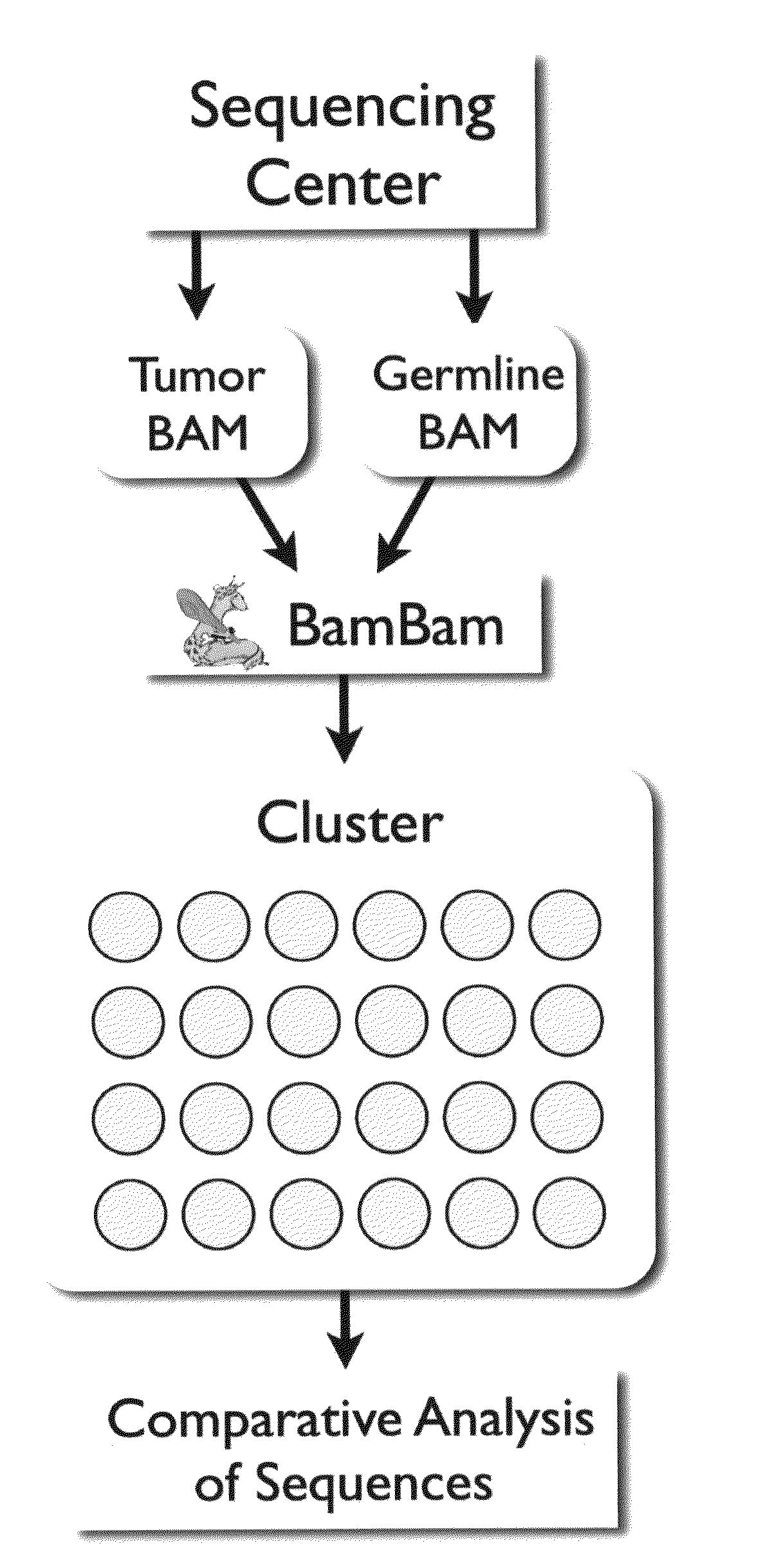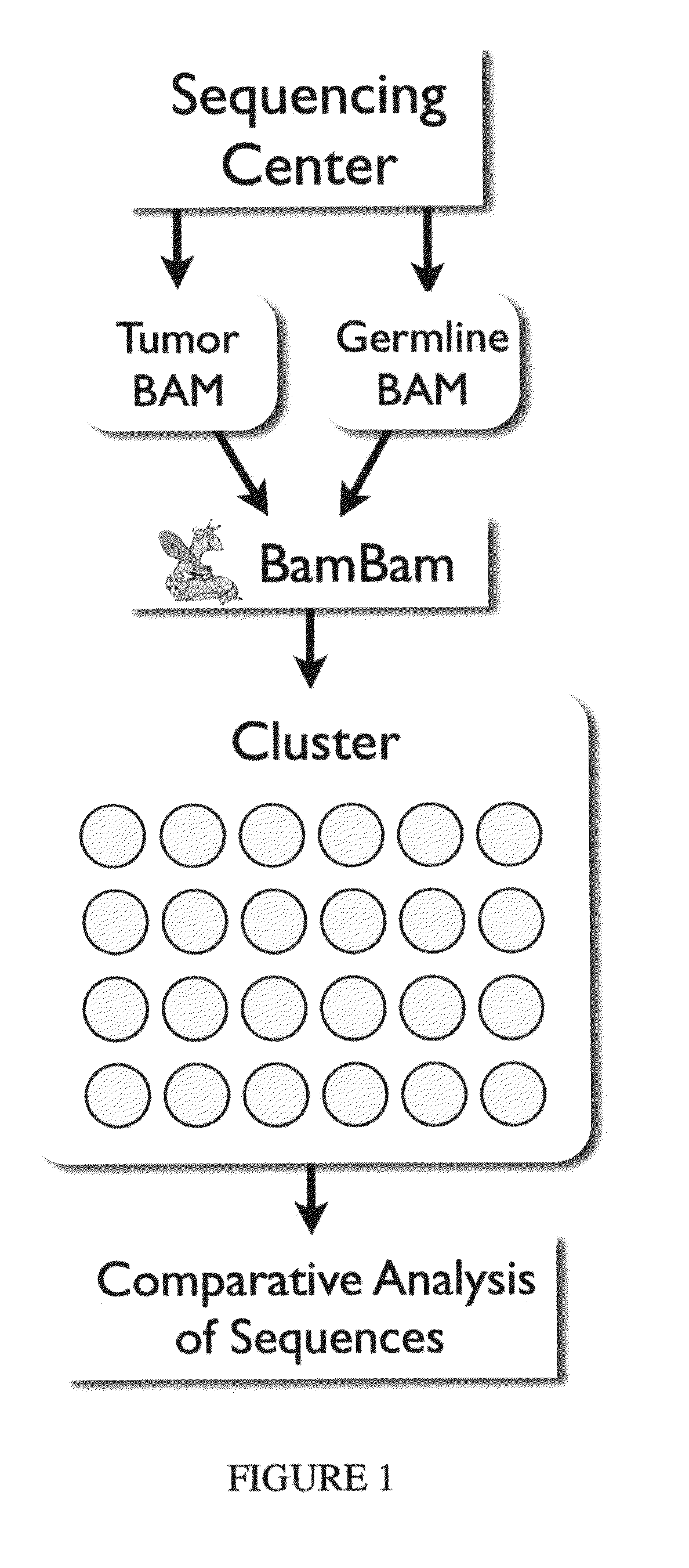Bambam: parallel comparative analysis of high-throughput sequencing data
a high-throughput sequencing and parallel technology, applied in computing models, instruments, medical practices/guidelines, etc., can solve the problems of slow analysis comparing a pair of these large datasets and difficult managemen
- Summary
- Abstract
- Description
- Claims
- Application Information
AI Technical Summary
Benefits of technology
Problems solved by technology
Method used
Image
Examples
example i
Dataset Synchronization Via the Reference Genome
[0092]All short reads are aligned to the same reference genome, making the reference genome a natural way of organizing sequence data from multiple, related samples. BamBam takes in two short read sequencing datasets, one from the tumor and the other a matched normal (“germline”) from the same patient, and the reference genome, and reads these datasets such that all sequences in both datasets overlapping the same genomic position are available to be processed at the same time. This is the most efficient method for processing such data, while also enabling complex analyses that would be difficult or impossible to accomplish in a serialized manner, where each dataset is processed by itself, and results are only merged afterwards.
[0093]Such a method is easily extendible to more than two related sequencing datasets. For example, if three samples, matched normal, tumor, and relapse, were sequenced, this method could be used to search for ch...
example ii
Somatic and Germline Variant Calling
[0094]Because BamBam keeps the sequence data in the pair of files in sync across the genome, a complex mutation model that requires sequencing data from both tumor and germline BAM files as well as the human reference can be implemented easily. This model aims to maximize the joint probability of both the germline genotype (given the germline reads and the reference nucleotide) and the genotype of the tumor (given the germline genotype, a simple mutation model, an estimate of the fraction of contaminating normal tissue in the tumor sample, and the tumor sequence data).
[0095]To find the optimal tumor and germline genotype, we aim to maximize the likelihood defined by
P(Dg,Dt,Gg,Gt|α,r)=P(Dg|Gg)P(Gg|r)P(Dt|Gg,Gt,α)P(Gt|Gg) (1)
P(D↓g,D↓t,G↓g,G↓t┤|α,r)=P(D↓g┤|G↓g)P(G↓g┤|r)P(D↓t┤|G↓g,G↓t,α)P(G↓t┤|G↓g) (1)
where r is the observed reference allele, α the fraction of normal contamination, and the tumor and germline genotypes are defined by Gt=(t1, t2) and ...
example iii
Overall and Allele-Specific Copy Number
[0101]Overall somatic copy number is calculated using a dynamic windowing approach that expands and contracts the window's genomic width according to the coverage in either the tumor or germline data. The process is initialized with a window of zero width. Each unique read from either the tumor or germline sequence data will be tallied into tumor counts, Nt, or germline counts, Ng. The start and stop positions of each read will define the window's region, expanding as new reads exceed the boundaries of the current window. When either the tumor or germline counts exceed a user-defined threshold, the window's size and location are recorded, as well as the Nt, Ng, and relative coverage Nt. Tailoring the size of the Ng window according to the local read coverage will create large windows in regions of low coverage (for example, repetitive regions) or small windows in regions exhibiting somatic amplification, thereby increasing the genomic resolutio...
PUM
| Property | Measurement | Unit |
|---|---|---|
| Fraction | aaaaa | aaaaa |
| Fraction | aaaaa | aaaaa |
| Length | aaaaa | aaaaa |
Abstract
Description
Claims
Application Information
 Login to View More
Login to View More - R&D
- Intellectual Property
- Life Sciences
- Materials
- Tech Scout
- Unparalleled Data Quality
- Higher Quality Content
- 60% Fewer Hallucinations
Browse by: Latest US Patents, China's latest patents, Technical Efficacy Thesaurus, Application Domain, Technology Topic, Popular Technical Reports.
© 2025 PatSnap. All rights reserved.Legal|Privacy policy|Modern Slavery Act Transparency Statement|Sitemap|About US| Contact US: help@patsnap.com



